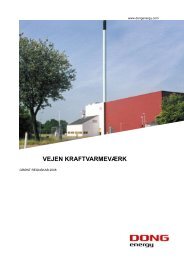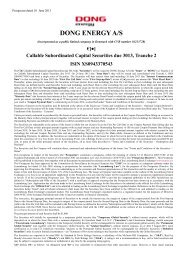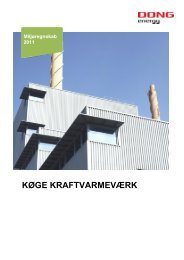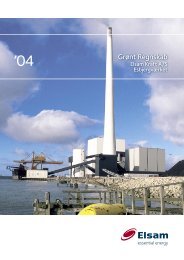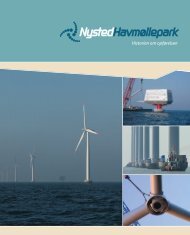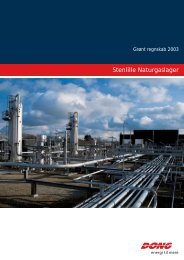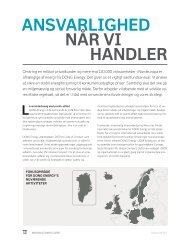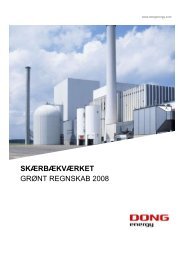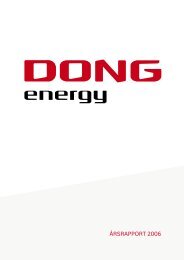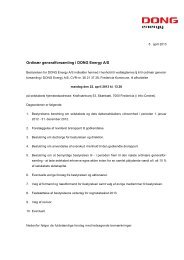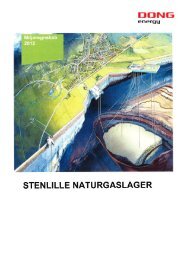ANNUAL REPORT 2011 - DONG Energy
ANNUAL REPORT 2011 - DONG Energy
ANNUAL REPORT 2011 - DONG Energy
You also want an ePaper? Increase the reach of your titles
YUMPU automatically turns print PDFs into web optimized ePapers that Google loves.
consolIdated NON-FINANCIAL STATEMENTS<br />
recognised based on <strong>DONG</strong> <strong>Energy</strong>’s proportionate overall<br />
ownership interest. However, a triviality rule has been introduced,<br />
which means that facilities with a total installed<br />
electricity, heat or steam capacity of less than 10 MW are<br />
omitted. Mongstad power station is also included as it is<br />
owned and operated by <strong>DONG</strong> <strong>Energy</strong> (however, the plant<br />
is not consolidated financially).<br />
Specific CO emissions (g CO /kWh) are calculated by<br />
2 2<br />
converting heat and steam to electricity equivalents. The<br />
equivalent electricity supplies represent the volume of<br />
additional electricity that could have been supplied if<br />
the power stations had not been generating heat and/or<br />
steam.<br />
Waste is not recognised as being a 100% CO -neutral fuel:<br />
2<br />
a conversion factor of 35 kg CO /GJ from incinerated waste<br />
2<br />
to CO emissions is applied. Biomass, biogas, landfill gas<br />
2<br />
and livestock manure are recognised as CO -neutral.<br />
2<br />
Emission and production data are collected applying the<br />
normal quality criteria, with the exception of data from associates,<br />
where a lower quality level is accepted. Data from<br />
the associate Stadtwerke Lübeck GmbH have not been<br />
recognised, as no data were available.<br />
Power station nitrogen oxide (NOx) and sulphur dioxide<br />
(SO2) emissions are mainly determined based on continuous<br />
measurement. A few power stations use plant-specific<br />
emission factors to calculate emissions. Specific emissions<br />
are determined as physical NOx/SO2 emissions from<br />
power stations relative to their total physical production of<br />
electricity, heat and steam supplied to the grid.<br />
Specific emissions (g NOx/SOx per kWh) are calculated<br />
by converting heat and steam to electricity equivalents.<br />
The equivalent electricity supplies represent the volume<br />
of additional electricity that could have been supplied if<br />
the power stations had not been generating heat and/or<br />
steam.<br />
Flaring of natural gas at offshore installations is determined<br />
using ultrasonic measurements. Volumes for the gas<br />
storage facility are calculated based on pressure and the<br />
dimension of the emptied process plant.<br />
154 COnsOliDatED nOn-finanCial statEmEnts – <strong>DONG</strong> ENERGY <strong>ANNUAL</strong> <strong>REPORT</strong> <strong>2011</strong><br />
Oil discharged to sea from production platforms is determined<br />
on the basis of extracted and reinjected volume,<br />
including measurements of content (oil and water). Oil<br />
discharged with produced water is calculated on the basis<br />
of three daily samples that are analysed for oil content and<br />
one sample every 24 hours based on ballast water.<br />
Reinjection of produced water at production platforms is<br />
determined based on pump capacity, pressure and time.<br />
Green proportion of electricity and heat generation<br />
The green proportion of electricity and heat generation is<br />
measured as generation from renewable energy, including<br />
generation from biomass and waste at power stations. In<br />
that connection, half of the electricity and heat generated<br />
from waste is recognised as green, while the other<br />
half is recognised as fossil. The proportion of generation<br />
from power stations that is based on biomass and waste<br />
is calculated as the ratio of the energy content of the fuels<br />
concerned to the total energy content of the fuels used at<br />
each plant. To allow a compilation of generation at power<br />
stations that generate both electricity and heat, and for the<br />
Group as a whole, heat generation is converted to equivalent<br />
electricity generation, i.e. the electricity that could<br />
have been generated if the power station(s) had not been<br />
generating heat. The same delimitation is used for measuring<br />
the green proportion of electricity and heat generation<br />
as is used or measuring g CO /kWh. 2<br />
recycling of waste<br />
Waste and recycling of same are measured on the basis of<br />
invoices received from waste recipients and/or using plantspecific<br />
measuring methods for production facilities.<br />
Waste from buildings that accommodate one per cent<br />
or less of the total number of employees is not reported.<br />
Waste from the construction of office buildings is not recognised,<br />
as the contractor disposes of waste as part of the<br />
design-build contract.<br />
For offshore installations and power stations, the reporting<br />
includes drilling projects and projects at existing installations,<br />
as waste data from projects form part of the plants’<br />
overall waste data.



